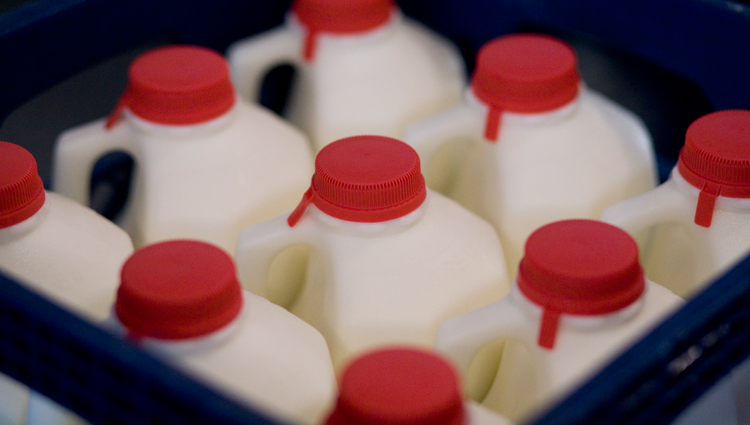Our fourth stop in the journey of milk from the farm to the table is processing and packaging. This is the step in the process where the milk is pasteurized and packaged at a dairy processing facility for shipment to grocery stores.
You’ll recall that milk is delivered to dairy processing plants in large tanker trucks. Once the milk is unloaded from the tanker truck, it is put through a separator – a centrifuge-type machine that separates the milk into cream (fat) and skimmed milk. Regardless of the level of fat desired in the final fluid milk product, all milk goes through this step (yes, even whole milk) so that the precise amount of milk fat can be added back. While no fat is added back to skim milk; 1 percent, 2 percent and whole milk (3.5 percent fat) will have the respective amount of fat added back – this way, every time you choose 1 percent milk, it is the same as the time before. The percentage signifies the amount of fat in the milk by weight.
The next step is to add vitamins A and D to the milk. Whole milk naturally contains vitamin A and some vitamin D, but is supplemented in low-fat milk products to meet a certain “standard of identity” for milk (2,000 International Units of vitamin A and 400 International Units of vitamin D). Supplementation of milk with vitamin D has helped to reduce the prevalence of rickets and other bone weakening conditions.
After vitamin supplementation, milk is homogenized. This is a mechanical process where milk is pumped through fine holes under high pressure to decrease milk fat globule size. Because fat is less dense than water, fat naturally separates and rises to the top of milk when it is not homogenized – while not harmful to have a layer of cream on the top of your milk, most consumers would rather not have it. Homogenization helps create a smooth, uniform and appealing texture by dispersing the smaller fat molecules throughout the milk. Homogenization has no effect on the nutritional quality of milk.
Lastly, milk is pasteurized – a process of heating raw milk at a high enough temperature for a sufficient length of time to destroy bacteria which can cause serious illnesses, as well as yeasts and molds. Traditional pasteurization heats the milk to 161 degrees Fahrenheit for a minimum of 15 seconds while ultra high temperature pasteurization heats the milk to 280 degrees Fahrenheit for a minimum of 1 to 2 seconds. Both methods ensure the milk is safe to drink and do not effect milk’s nutritive value. The high temp also breaks down enzymes that can cause the milk to become rancid – thus allowing milk to stay fresh longer.
Milk is then quickly cooled and packaged into bottles or cartons. During and after packaging, milk is kept cold in large refrigerated rooms. For every degree over 40 that milk reaches, the shelf life is reduced by 24 hours. This is why keeping milk cold is paramount to ensuring a high quality product.
Check out the full series:
- The Art and Science of Dairy from Farm to Table: An Intro
- The Art and Science of Dairy from Farm to Table: Production of Feed and Reducing Waste
- The Art and Science of Dairy from Farm to Table: Milk Production
- The Art and Science of Dairy from Farm to Table: Raw Milk Transport
- The Art and Science of Dairy from Farm to Table: Processing and Packaging
- The Art and Science of Dairy from Farm to Table: Retail and Distribution




